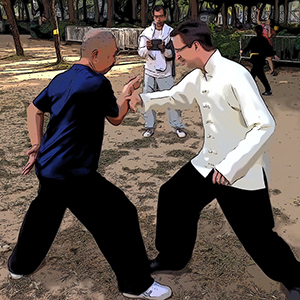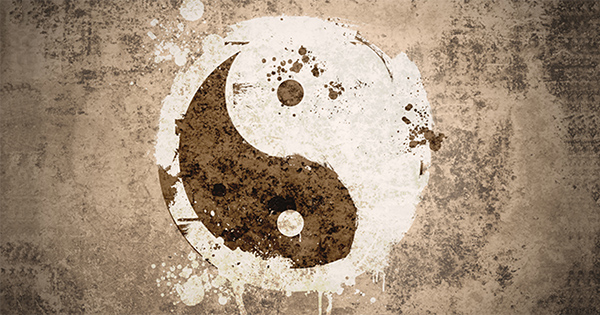When contacting a partner/opponent, it is important to remain comfortable (舒服 shufu) and to maintain joint mobility even when interacting under pressure. In order to have comfortable mobility, it is important that the “nine pearl bends” (九曲珠 jiu qu zhu), the major joints of the body, are aligned with force/energy transmitted through (or spiraling around) stable but free to move centers. We perform better under pressure when we are not stressed or agitated, and can maintain a calm attention. This is all a part of our Taijiquan training.
We train to sense the instabilities and places that lack mobility in our partner/opponent. If we can sense their excesses and insufficiencies, then we can use these to control their ability to produce power as well as making them vulnerable to our attacks. We often use one point of contact with them to disrupt their structure, root, ability to change, etc., and attack with another part of our body.
 Affecting the partner/opponent’s nine pearl bends is sometimes referred to as breaking a link in the partner/opponent’s chain. If their joints (links) are not properly aligned, then they will have difficulty transmitting power through them (the chain); their power will leak out to the sides rather than being transmitted through the structure as intended. Even if they are stronger than us, if they cannot effectively use that strength due to disruptions in their chain, then their interaction will be as if they are weaker.
Affecting the partner/opponent’s nine pearl bends is sometimes referred to as breaking a link in the partner/opponent’s chain. If their joints (links) are not properly aligned, then they will have difficulty transmitting power through them (the chain); their power will leak out to the sides rather than being transmitted through the structure as intended. Even if they are stronger than us, if they cannot effectively use that strength due to disruptions in their chain, then their interaction will be as if they are weaker.
A larger mass is harder to move unless its center of balance is near the edge of the base of support. This is one aspect of what push-hands (推手 tui shou) trains; compromising a partner/opponent’s stability upon contact. If they are unstable, then they are like a book overhanging the edge of a desk, easy to knock off without using much force. The skill is in both sensing how to destabilize the partner/opponent, and in maintaining that control as long as desired, however brief that may be.
Rather than training to overpower a partner/opponent (using force against force), we train to disrupt their stability while maintaining our own stability (central equilibrium, 中定 zhong ding). We attack a weakened partner/opponent. Because they will try to respond to destabilization and recover their balance, we must train to maintain our changeability so that we can respond appropriately and keep them from recovering. We want to attack when they are unstable, and therefore vulnerable.
Through contact training (e.g., push-hands and san shou 散手) we learn about timing (時間 shi jian), opportunity (機会 ji hui), angles (角度 jiao du), balance (平衡 ping heng), and other factors that aid us in controlling interactive situations, even when against bigger partners/opponents.
We train to have both yin (阴) and yang (阳) at the point of contact with a partner/opponent, which allows us to simultaneously have the potential for both push and pull (having both yin and yang complement each other) rather than only push OR pull. We want to avoid stopping between pushing and pulling, or pulling and pushing. We train to avoid these breaks, or gaps in potential, by emphasizing circularity. A circle has no beginning or end, and it changes continuously and smoothly.
Yang Chengfu (楊澄甫), as recorded by Chen Weiming (陳微明) and translated by Paul Brennan, addressed this topic as follows:
“In external styles of boxing arts, their strength is only the clumsy strength of acquired habit. Therefore there is a start and a stop, a continuing and an interrupting. It is when old force is spent and new force is not yet initiated that is the easiest moment for an opponent to take advantage of. Taiji uses intention, not exertion, and so from beginning to end, it is continuous without interruption, recycling endlessly.”
In Taijiquan we want to maintain our potential to move in any direction so that we are never prevented from being able to respond to any situational changes. But we welcome when our partner/opponent reveals their force by committing to one primary direction. While we avoid the “force against force” head-on opposition to their primary direction, we can either let their force dissipate when their attack has reached full expression, or we control that force from their weak angles.
Once someone expresses power, they typically align their structure to support that direction. If they are not mindful of maintaining potential for movement in all directions, then their strength in one primary direction will reveal weaknesses from other directions. Engaging them from their weak directions means that they are at a reduced level of power, even if they are bigger (more massive) than us.
Keys to making size not matter against Taijiquan lie in the ability to destabilize the partner/opponent and/or to lead them off target. When we defend we want to use the minimal amount of force possible, in order to make our control by leading less detectable. When the partner/opponent’s direction of force is only subtly influenced, rather than being stopped by blocking, then their momentum is likely to continue. This momentum, and/or the stop at the ending, allows us to gain opportunities for counterattacks. When we attack, or counterattack, we want to avoid the angles where they are strong, and to position ourselves at their weak angles.
Of course, if one were to go head to head, or use force against force, then size would matter and the person with the greater mass would have the advantage.

Leave a Reply